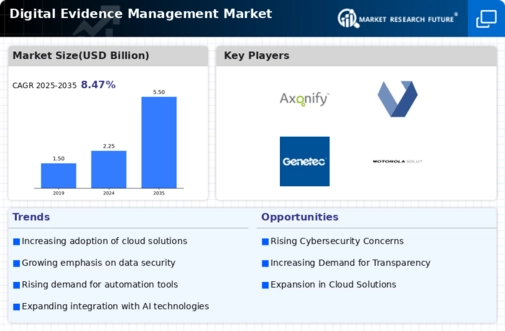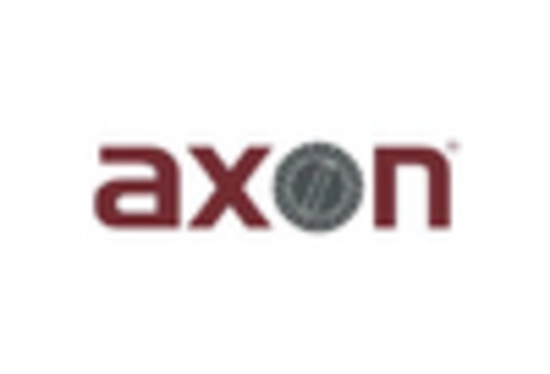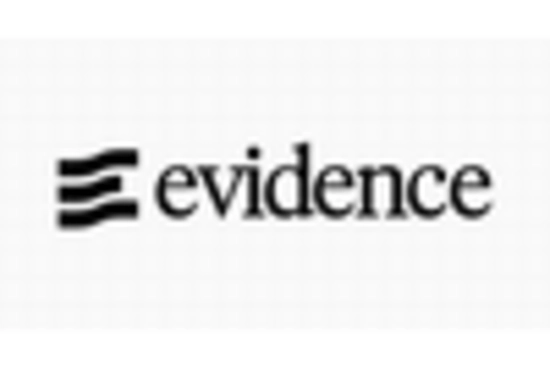-
FACTOR ANALYSIS
-
\r\n\r\n\r\nValue chain Analysis
-
\r\n\r\n\r\nPorter's
-
Five Forces Analysis
-
\r\n\r\n\r\nBargaining Power of Suppliers
-
\r\n\r\n\r\nBargaining
-
Power of Buyers
-
\r\n\r\n\r\nThreat of New Entrants
-
\r\n\r\n\r\nThreat
-
of Substitutes
-
\r\n\r\n\r\nIntensity of Rivalry
-
\r\n\r\n\r\n\r\n\r\nCOVID-19
-
Impact Analysis
-
\r\n\r\n\r\nMarket Impact Analysis
-
\r\n\r\n\r\nRegional
-
Impact
-
\r\n\r\n\r\nOpportunity and Threat Analysis
-
\r\n\r\n\r\n\r\n\r\n\r\n\r\n\r\n\r\nDigital
-
Evidence Management Market, BY Application (USD Billion)
-
\r\n\r\n\r\nLaw
-
Enforcement
-
\r\n\r\n\r\nJudicial
-
\r\n\r\n\r\nCorporate
-
Security
-
\r\n\r\n\r\nForensic Analysis
-
\r\n\r\n\r\n\r\n\r\nDigital
-
Evidence Management Market, BY Deployment Type (USD Billion)
-
\r\n\r\n\r\nOn-Premises
-
\r\n\r\n\r\nCloud-Based
-
\r\n\r\n\r\nHybrid
-
\r\n\r\n\r\n\r\n\r\nDigital
-
Evidence Management Market, BY Component (USD Billion)
-
\r\n\r\n\r\nSoftware
-
\r\n\r\n\r\nHardware
-
\r\n\r\n\r\nServices
-
\r\n\r\n\r\n\r\n\r\nDigital
-
Evidence Management Market, BY End Use (USD Billion)
-
\r\n\r\n\r\nGovernment
-
Agencies
-
\r\n\r\n\r\nPrivate Sector
-
\r\n\r\n\r\nLegal
-
Firms
-
\r\n\r\n\r\n\r\n\r\nDigital Evidence Management
-
Market, BY Regional (USD Billion)
-
\r\n\r\n\r\nNorth America
-
\r\n\r\n\r\nUS
-
\r\n\r\n\r\nCanada
-
\r\n\r\n\r\n\r\n\r\nEurope
-
\r\n\r\n\r\nGermany
-
\r\n\r\n\r\nUK
-
\r\n\r\n\r\nFrance
-
\r\n\r\n\r\nRussia
-
\r\n\r\n\r\nItaly
-
\r\n\r\n\r\nSpain
-
\r\n\r\n\r\nRest
-
of Europe
-
\r\n\r\n\r\n\r\n\r\nAPAC
-
\r\n\r\n\r\nChina
-
\r\n\r\n\r\nIndia
-
\r\n\r\n\r\nJapan
-
\r\n\r\n\r\nSouth
-
Korea
-
\r\n\r\n\r\nMalaysia
-
\r\n\r\n\r\nThailand
-
\r\n\r\n\r\nIndonesia
-
\r\n\r\n\r\nRest
-
of APAC
-
\r\n\r\n\r\n\r\n\r\nSouth America
-
\r\n\r\n\r\nBrazil
-
\r\n\r\n\r\nMexico
-
\r\n\r\n\r\nArgentina
-
\r\n\r\n\r\nRest
-
of South America
-
\r\n\r\n\r\n\r\n\r\nMEA
-
\r\n\r\n\r\nGCC
-
Countries
-
\r\n\r\n\r\nSouth Africa
-
\r\n\r\n\r\nRest
-
of MEA
-
\r\n\r\n\r\n\r\n\r\n\r\n\r\n\r\n\r\nCompetitive
-
Landscape
-
\r\n\r\n\r\nOverview
-
\r\n\r\n\r\nCompetitive
-
Analysis
-
\r\n\r\n\r\nMarket share Analysis
-
\r\n\r\n\r\nMajor
-
Growth Strategy in the Digital Evidence Management Market
-
\r\n\r\n\r\nCompetitive
-
Benchmarking
-
\r\n\r\n\r\nLeading Players in Terms of Number of Developments
-
in the Digital Evidence Management Market
-
\r\n\r\n\r\nKey developments
-
and growth strategies
-
\r\n\r\n\r\nNew Product Launch/Service Deployment
-
\r\n\r\n\r\nMerger
-
& Acquisitions
-
\r\n\r\n\r\nJoint Ventures
-
\r\n\r\n\r\n\r\n\r\nMajor
-
Players Financial Matrix
-
\r\n\r\n\r\nSales and Operating Income
-
\r\n\r\n\r\nMajor
-
Players R&D Expenditure. 2023
-
\r\n\r\n\r\n\r\n\r\n\r\n\r\nCompany
-
Profiles
-
\r\n\r\n\r\nEvidence.com
-
\r\n\r\n\r\nFinancial
-
Overview
-
\r\n\r\n\r\nProducts Offered
-
\r\n\r\n\r\nKey
-
Developments
-
\r\n\r\n\r\nSWOT Analysis
-
\r\n\r\n\r\nKey
-
Strategies
-
\r\n\r\n\r\n\r\n\r\nPinnacle Data Systems
-
\r\n\r\n\r\nFinancial
-
Overview
-
\r\n\r\n\r\nProducts Offered
-
\r\n\r\n\r\nKey
-
Developments
-
\r\n\r\n\r\nSWOT Analysis
-
\r\n\r\n\r\nKey
-
Strategies
-
\r\n\r\n\r\n\r\n\r\nZetron
-
\r\n\r\n\r\nFinancial
-
Overview
-
\r\n\r\n\r\nProducts Offered
-
\r\n\r\n\r\nKey
-
Developments
-
\r\n\r\n\r\nSWOT Analysis
-
\r\n\r\n\r\nKey
-
Strategies
-
\r\n\r\n\r\n\r\n\r\nDVR.com
-
\r\n\r\n\r\nFinancial
-
Overview
-
\r\n\r\n\r\nProducts Offered
-
\r\n\r\n\r\nKey
-
Developments
-
\r\n\r\n\r\nSWOT Analysis
-
\r\n\r\n\r\nKey
-
Strategies
-
\r\n\r\n\r\n\r\n\r\nMotorola Solutions
-
\r\n\r\n\r\nFinancial
-
Overview
-
\r\n\r\n\r\nProducts Offered
-
\r\n\r\n\r\nKey
-
Developments
-
\r\n\r\n\r\nSWOT Analysis
-
\r\n\r\n\r\nKey
-
Strategies
-
\r\n\r\n\r\n\r\n\r\nVerint Systems
-
\r\n\r\n\r\nFinancial
-
Overview
-
\r\n\r\n\r\nProducts Offered
-
\r\n\r\n\r\nKey
-
Developments
-
\r\n\r\n\r\nSWOT Analysis
-
\r\n\r\n\r\nKey
-
Strategies
-
\r\n\r\n\r\n\r\n\r\nCivica
-
\r\n\r\n\r\nFinancial
-
Overview
-
\r\n\r\n\r\nProducts Offered
-
\r\n\r\n\r\nKey
-
Developments
-
\r\n\r\n\r\nSWOT Analysis
-
\r\n\r\n\r\nKey
-
Strategies
-
\r\n\r\n\r\n\r\n\r\nAxon Enterprise
-
\r\n\r\n\r\nFinancial
-
Overview
-
\r\n\r\n\r\nProducts Offered
-
\r\n\r\n\r\nKey
-
Developments
-
\r\n\r\n\r\nSWOT Analysis
-
\r\n\r\n\r\nKey
-
Strategies
-
\r\n\r\n\r\n\r\n\r\nKustom Signals
-
\r\n\r\n\r\nFinancial
-
Overview
-
\r\n\r\n\r\nProducts Offered
-
\r\n\r\n\r\nKey
-
Developments
-
\r\n\r\n\r\nSWOT Analysis
-
\r\n\r\n\r\nKey
-
Strategies
-
\r\n\r\n\r\n\r\n\r\nDigital Ally
-
\r\n\r\n\r\nFinancial
-
Overview
-
\r\n\r\n\r\nProducts Offered
-
\r\n\r\n\r\nKey
-
Developments
-
\r\n\r\n\r\nSWOT Analysis
-
\r\n\r\n\r\nKey
-
Strategies
-
\r\n\r\n\r\n\r\n\r\nNEC Corporation
-
\r\n\r\n\r\nFinancial
-
Overview
-
\r\n\r\n\r\nProducts Offered
-
\r\n\r\n\r\nKey
-
Developments
-
\r\n\r\n\r\nSWOT Analysis
-
\r\n\r\n\r\nKey
-
Strategies
-
\r\n\r\n\r\n\r\n\r\nCaseGuard
-
\r\n\r\n\r\nFinancial
-
Overview
-
\r\n\r\n\r\nProducts Offered
-
\r\n\r\n\r\nKey
-
Developments
-
\r\n\r\n\r\nSWOT Analysis
-
\r\n\r\n\r\nKey
-
Strategies
-
\r\n\r\n\r\n\r\n\r\nRelativity
-
\r\n\r\n\r\nFinancial
-
Overview
-
\r\n\r\n\r\nProducts Offered
-
\r\n\r\n\r\nKey
-
Developments
-
\r\n\r\n\r\nSWOT Analysis
-
\r\n\r\n\r\nKey
-
Strategies
-
\r\n\r\n\r\n\r\n\r\nDigiCert
-
\r\n\r\n\r\nFinancial
-
Overview
-
\r\n\r\n\r\nProducts Offered
-
\r\n\r\n\r\nKey
-
Developments
-
\r\n\r\n\r\nSWOT Analysis
-
\r\n\r\n\r\nKey
-
Strategies
-
\r\n\r\n\r\n\r\n\r\nGenetec
-
\r\n\r\n\r\nFinancial
-
Overview
-
\r\n\r\n\r\nProducts Offered
-
\r\n\r\n\r\nKey
-
Developments
-
\r\n\r\n\r\nSWOT Analysis
-
\r\n\r\n\r\nKey
-
Strategies
-
\r\n\r\n\r\n\r\n\r\n\r\n\r\nAppendix
-
\r\n\r\n\r\nReferences
-
\r\n\r\n\r\nRelated
-
Reports
-
\r\n\r\n\r\n\r\n\r\nLIST Of tables
-
\r\n\r\n\r\nLIST
-
OF ASSUMPTIONS
-
\r\n\r\n\r\nNorth America Digital Evidence Management
-
Market SIZE ESTIMATES & FORECAST, BY APPLICATION, 2019-2035 (USD Billions)
-
\r\n\r\n\r\nNorth
-
America Digital Evidence Management Market SIZE ESTIMATES & FORECAST, BY DEPLOYMENT
-
TYPE, 2019-2035 (USD Billions)
-
\r\n\r\n\r\nNorth America Digital
-
Evidence Management Market SIZE ESTIMATES & FORECAST, BY COMPONENT, 2019-2035
-
(USD Billions)
-
\r\n\r\n\r\nNorth America Digital Evidence Management
-
Market SIZE ESTIMATES & FORECAST, BY END USE, 2019-2035 (USD Billions)
-
\r\n\r\n\r\nNorth
-
America Digital Evidence Management Market SIZE ESTIMATES & FORECAST, BY REGIONAL,
-
\r\n\r\n\r\nUS Digital Evidence Management
-
Market SIZE ESTIMATES & FORECAST, BY APPLICATION, 2019-2035 (USD Billions)
-
\r\n\r\n\r\nUS
-
Digital Evidence Management Market SIZE ESTIMATES & FORECAST, BY DEPLOYMENT
-
TYPE, 2019-2035 (USD Billions)
-
\r\n\r\n\r\nUS Digital Evidence Management
-
Market SIZE ESTIMATES & FORECAST, BY COMPONENT, 2019-2035 (USD Billions)
-
\r\n\r\n\r\nUS
-
Digital Evidence Management Market SIZE ESTIMATES & FORECAST, BY END USE, 2019-2035
-
(USD Billions)
-
\r\n\r\n\r\nUS Digital Evidence Management Market
-
SIZE ESTIMATES & FORECAST, BY REGIONAL, 2019-2035 (USD Billions)
-
\r\n\r\n\r\nCanada
-
Digital Evidence Management Market SIZE ESTIMATES & FORECAST, BY APPLICATION,
-
\r\n\r\n\r\nCanada Digital Evidence Management
-
Market SIZE ESTIMATES & FORECAST, BY DEPLOYMENT TYPE, 2019-2035 (USD Billions)
-
\r\n\r\n\r\nCanada
-
Digital Evidence Management Market SIZE ESTIMATES & FORECAST, BY COMPONENT,
-
\r\n\r\n\r\nCanada Digital Evidence Management
-
Market SIZE ESTIMATES & FORECAST, BY END USE, 2019-2035 (USD Billions)
-
\r\n\r\n\r\nCanada
-
Digital Evidence Management Market SIZE ESTIMATES & FORECAST, BY REGIONAL, 2019-2035
-
(USD Billions)
-
\r\n\r\n\r\nEurope Digital Evidence Management Market
-
SIZE ESTIMATES & FORECAST, BY APPLICATION, 2019-2035 (USD Billions)
-
\r\n\r\n\r\nEurope
-
Digital Evidence Management Market SIZE ESTIMATES & FORECAST, BY DEPLOYMENT
-
TYPE, 2019-2035 (USD Billions)
-
\r\n\r\n\r\nEurope Digital Evidence
-
Management Market SIZE ESTIMATES & FORECAST, BY COMPONENT, 2019-2035 (USD Billions)
-
\r\n\r\n\r\nEurope
-
Digital Evidence Management Market SIZE ESTIMATES & FORECAST, BY END USE, 2019-2035
-
(USD Billions)
-
\r\n\r\n\r\nEurope Digital Evidence Management Market
-
SIZE ESTIMATES & FORECAST, BY REGIONAL, 2019-2035 (USD Billions)
-
\r\n\r\n\r\nGermany
-
Digital Evidence Management Market SIZE ESTIMATES & FORECAST, BY APPLICATION,
-
\r\n\r\n\r\nGermany Digital Evidence Management
-
Market SIZE ESTIMATES & FORECAST, BY DEPLOYMENT TYPE, 2019-2035 (USD Billions)
-
\r\n\r\n\r\nGermany
-
Digital Evidence Management Market SIZE ESTIMATES & FORECAST, BY COMPONENT,
-
\r\n\r\n\r\nGermany Digital Evidence Management
-
Market SIZE ESTIMATES & FORECAST, BY END USE, 2019-2035 (USD Billions)
-
\r\n\r\n\r\nGermany
-
Digital Evidence Management Market SIZE ESTIMATES & FORECAST, BY REGIONAL, 2019-2035
-
(USD Billions)
-
\r\n\r\n\r\nUK Digital Evidence Management Market
-
SIZE ESTIMATES & FORECAST, BY APPLICATION, 2019-2035 (USD Billions)
-
\r\n\r\n\r\nUK
-
Digital Evidence Management Market SIZE ESTIMATES & FORECAST, BY DEPLOYMENT
-
TYPE, 2019-2035 (USD Billions)
-
\r\n\r\n\r\nUK Digital Evidence Management
-
Market SIZE ESTIMATES & FORECAST, BY COMPONENT, 2019-2035 (USD Billions)
-
\r\n\r\n\r\nUK
-
Digital Evidence Management Market SIZE ESTIMATES & FORECAST, BY END USE, 2019-2035
-
(USD Billions)
-
\r\n\r\n\r\nUK Digital Evidence Management Market
-
SIZE ESTIMATES & FORECAST, BY REGIONAL, 2019-2035 (USD Billions)
-
\r\n\r\n\r\nFrance
-
Digital Evidence Management Market SIZE ESTIMATES & FORECAST, BY APPLICATION,
-
\r\n\r\n\r\nFrance Digital Evidence Management
-
Market SIZE ESTIMATES & FORECAST, BY DEPLOYMENT TYPE, 2019-2035 (USD Billions)
-
\r\n\r\n\r\nFrance
-
Digital Evidence Management Market SIZE ESTIMATES & FORECAST, BY COMPONENT,
-
\r\n\r\n\r\nFrance Digital Evidence Management
-
Market SIZE ESTIMATES & FORECAST, BY END USE, 2019-2035 (USD Billions)
-
\r\n\r\n\r\nFrance
-
Digital Evidence Management Market SIZE ESTIMATES & FORECAST, BY REGIONAL, 2019-2035
-
(USD Billions)
-
\r\n\r\n\r\nRussia Digital Evidence Management Market
-
SIZE ESTIMATES & FORECAST, BY APPLICATION, 2019-2035 (USD Billions)
-
\r\n\r\n\r\nRussia
-
Digital Evidence Management Market SIZE ESTIMATES & FORECAST, BY DEPLOYMENT
-
TYPE, 2019-2035 (USD Billions)
-
\r\n\r\n\r\nRussia Digital Evidence
-
Management Market SIZE ESTIMATES & FORECAST, BY COMPONENT, 2019-2035 (USD Billions)
-
\r\n\r\n\r\nRussia
-
Digital Evidence Management Market SIZE ESTIMATES & FORECAST, BY END USE, 2019-2035
-
(USD Billions)
-
\r\n\r\n\r\nRussia Digital Evidence Management Market
-
SIZE ESTIMATES & FORECAST, BY REGIONAL, 2019-2035 (USD Billions)
-
\r\n\r\n\r\nItaly
-
Digital Evidence Management Market SIZE ESTIMATES & FORECAST, BY APPLICATION,
-
\r\n\r\n\r\nItaly Digital Evidence Management
-
Market SIZE ESTIMATES & FORECAST, BY DEPLOYMENT TYPE, 2019-2035 (USD Billions)
-
\r\n\r\n\r\nItaly
-
Digital Evidence Management Market SIZE ESTIMATES & FORECAST, BY COMPONENT,
-
\r\n\r\n\r\nItaly Digital Evidence Management
-
Market SIZE ESTIMATES & FORECAST, BY END USE, 2019-2035 (USD Billions)
-
\r\n\r\n\r\nItaly
-
Digital Evidence Management Market SIZE ESTIMATES & FORECAST, BY REGIONAL, 2019-2035
-
(USD Billions)
-
\r\n\r\n\r\nSpain Digital Evidence Management Market
-
SIZE ESTIMATES & FORECAST, BY APPLICATION, 2019-2035 (USD Billions)
-
\r\n\r\n\r\nSpain
-
Digital Evidence Management Market SIZE ESTIMATES & FORECAST, BY DEPLOYMENT
-
TYPE, 2019-2035 (USD Billions)
-
\r\n\r\n\r\nSpain Digital Evidence
-
Management Market SIZE ESTIMATES & FORECAST, BY COMPONENT, 2019-2035 (USD Billions)
-
\r\n\r\n\r\nSpain
-
Digital Evidence Management Market SIZE ESTIMATES & FORECAST, BY END USE, 2019-2035
-
(USD Billions)
-
\r\n\r\n\r\nSpain Digital Evidence Management Market
-
SIZE ESTIMATES & FORECAST, BY REGIONAL, 2019-2035 (USD Billions)
-
\r\n\r\n\r\nRest
-
of Europe Digital Evidence Management Market SIZE ESTIMATES & FORECAST, BY APPLICATION,
-
\r\n\r\n\r\nRest of Europe Digital Evidence
-
Management Market SIZE ESTIMATES & FORECAST, BY DEPLOYMENT TYPE, 2019-2035 (USD
-
Billions)
-
\r\n\r\n\r\nRest of Europe Digital Evidence Management
-
Market SIZE ESTIMATES & FORECAST, BY COMPONENT, 2019-2035 (USD Billions)
-
\r\n\r\n\r\nRest
-
of Europe Digital Evidence Management Market SIZE ESTIMATES & FORECAST, BY END
-
USE, 2019-2035 (USD Billions)
-
\r\n\r\n\r\nRest of Europe Digital
-
Evidence Management Market SIZE ESTIMATES & FORECAST, BY REGIONAL, 2019-2035
-
(USD Billions)
-
\r\n\r\n\r\nAPAC Digital Evidence Management Market
-
SIZE ESTIMATES & FORECAST, BY APPLICATION, 2019-2035 (USD Billions)
-
\r\n\r\n\r\nAPAC
-
Digital Evidence Management Market SIZE ESTIMATES & FORECAST, BY DEPLOYMENT
-
TYPE, 2019-2035 (USD Billions)
-
\r\n\r\n\r\nAPAC Digital Evidence
-
Management Market SIZE ESTIMATES & FORECAST, BY COMPONENT, 2019-2035 (USD Billions)
-
\r\n\r\n\r\nAPAC
-
Digital Evidence Management Market SIZE ESTIMATES & FORECAST, BY END USE, 2019-2035
-
(USD Billions)
-
\r\n\r\n\r\nAPAC Digital Evidence Management Market
-
SIZE ESTIMATES & FORECAST, BY REGIONAL, 2019-2035 (USD Billions)
-
\r\n\r\n\r\nChina
-
Digital Evidence Management Market SIZE ESTIMATES & FORECAST, BY APPLICATION,
-
\r\n\r\n\r\nChina Digital Evidence Management
-
Market SIZE ESTIMATES & FORECAST, BY DEPLOYMENT TYPE, 2019-2035 (USD Billions)
-
\r\n\r\n\r\nChina
-
Digital Evidence Management Market SIZE ESTIMATES & FORECAST, BY COMPONENT,
-
\r\n\r\n\r\nChina Digital Evidence Management
-
Market SIZE ESTIMATES & FORECAST, BY END USE, 2019-2035 (USD Billions)
-
\r\n\r\n\r\nChina
-
Digital Evidence Management Market SIZE ESTIMATES & FORECAST, BY REGIONAL, 2019-2035
-
(USD Billions)
-
\r\n\r\n\r\nIndia Digital Evidence Management Market
-
SIZE ESTIMATES & FORECAST, BY APPLICATION, 2019-2035 (USD Billions)
-
\r\n\r\n\r\nIndia
-
Digital Evidence Management Market SIZE ESTIMATES & FORECAST, BY DEPLOYMENT
-
TYPE, 2019-2035 (USD Billions)
-
\r\n\r\n\r\nIndia Digital Evidence
-
Management Market SIZE ESTIMATES & FORECAST, BY COMPONENT, 2019-2035 (USD Billions)
-
\r\n\r\n\r\nIndia
-
Digital Evidence Management Market SIZE ESTIMATES & FORECAST, BY END USE, 2019-2035
-
(USD Billions)
-
\r\n\r\n\r\nIndia Digital Evidence Management Market
-
SIZE ESTIMATES & FORECAST, BY REGIONAL, 2019-2035 (USD Billions)
-
\r\n\r\n\r\nJapan
-
Digital Evidence Management Market SIZE ESTIMATES & FORECAST, BY APPLICATION,
-
\r\n\r\n\r\nJapan Digital Evidence Management
-
Market SIZE ESTIMATES & FORECAST, BY DEPLOYMENT TYPE, 2019-2035 (USD Billions)
-
\r\n\r\n\r\nJapan
-
Digital Evidence Management Market SIZE ESTIMATES & FORECAST, BY COMPONENT,
-
\r\n\r\n\r\nJapan Digital Evidence Management
-
Market SIZE ESTIMATES & FORECAST, BY END USE, 2019-2035 (USD Billions)
-
\r\n\r\n\r\nJapan
-
Digital Evidence Management Market SIZE ESTIMATES & FORECAST, BY REGIONAL, 2019-2035
-
(USD Billions)
-
\r\n\r\n\r\nSouth Korea Digital Evidence Management
-
Market SIZE ESTIMATES & FORECAST, BY APPLICATION, 2019-2035 (USD Billions)
-
\r\n\r\n\r\nSouth
-
Korea Digital Evidence Management Market SIZE ESTIMATES & FORECAST, BY DEPLOYMENT
-
TYPE, 2019-2035 (USD Billions)
-
\r\n\r\n\r\nSouth Korea Digital Evidence
-
Management Market SIZE ESTIMATES & FORECAST, BY COMPONENT, 2019-2035 (USD Billions)
-
\r\n\r\n\r\nSouth
-
Korea Digital Evidence Management Market SIZE ESTIMATES & FORECAST, BY END USE,
-
\r\n\r\n\r\nSouth Korea Digital Evidence
-
Management Market SIZE ESTIMATES & FORECAST, BY REGIONAL, 2019-2035 (USD Billions)
-
\r\n\r\n\r\nMalaysia
-
Digital Evidence Management Market SIZE ESTIMATES & FORECAST, BY APPLICATION,
-
\r\n\r\n\r\nMalaysia Digital Evidence Management
-
Market SIZE ESTIMATES & FORECAST, BY DEPLOYMENT TYPE, 2019-2035 (USD Billions)
-
\r\n\r\n\r\nMalaysia
-
Digital Evidence Management Market SIZE ESTIMATES & FORECAST, BY COMPONENT,
-
\r\n\r\n\r\nMalaysia Digital Evidence Management
-
Market SIZE ESTIMATES & FORECAST, BY END USE, 2019-2035 (USD Billions)
-
\r\n\r\n\r\nMalaysia
-
Digital Evidence Management Market SIZE ESTIMATES & FORECAST, BY REGIONAL, 2019-2035
-
(USD Billions)
-
\r\n\r\n\r\nThailand Digital Evidence Management Market
-
SIZE ESTIMATES & FORECAST, BY APPLICATION, 2019-2035 (USD Billions)
-
\r\n\r\n\r\nThailand
-
Digital Evidence Management Market SIZE ESTIMATES & FORECAST, BY DEPLOYMENT
-
TYPE, 2019-2035 (USD Billions)
-
\r\n\r\n\r\nThailand Digital Evidence
-
Management Market SIZE ESTIMATES & FORECAST, BY COMPONENT, 2019-2035 (USD Billions)
-
\r\n\r\n\r\nThailand
-
Digital Evidence Management Market SIZE ESTIMATES & FORECAST, BY END USE, 2019-2035
-
(USD Billions)
-
\r\n\r\n\r\nThailand Digital Evidence Management Market
-
SIZE ESTIMATES & FORECAST, BY REGIONAL, 2019-2035 (USD Billions)
-
\r\n\r\n\r\nIndonesia
-
Digital Evidence Management Market SIZE ESTIMATES & FORECAST, BY APPLICATION,
-
\r\n\r\n\r\nIndonesia Digital Evidence Management
-
Market SIZE ESTIMATES & FORECAST, BY DEPLOYMENT TYPE, 2019-2035 (USD Billions)
-
\r\n\r\n\r\nIndonesia
-
Digital Evidence Management Market SIZE ESTIMATES & FORECAST, BY COMPONENT,
-
\r\n\r\n\r\nIndonesia Digital Evidence Management
-
Market SIZE ESTIMATES & FORECAST, BY END USE, 2019-2035 (USD Billions)
-
\r\n\r\n\r\nIndonesia
-
Digital Evidence Management Market SIZE ESTIMATES & FORECAST, BY REGIONAL, 2019-2035
-
(USD Billions)
-
\r\n\r\n\r\nRest of APAC Digital Evidence Management
-
Market SIZE ESTIMATES & FORECAST, BY APPLICATION, 2019-2035 (USD Billions)
-
\r\n\r\n\r\nRest
-
of APAC Digital Evidence Management Market SIZE ESTIMATES & FORECAST, BY DEPLOYMENT
-
TYPE, 2019-2035 (USD Billions)
-
\r\n\r\n\r\nRest of APAC Digital Evidence
-
Management Market SIZE ESTIMATES & FORECAST, BY COMPONENT, 2019-2035 (USD Billions)
-
\r\n\r\n\r\nRest
-
of APAC Digital Evidence Management Market SIZE ESTIMATES & FORECAST, BY END
-
USE, 2019-2035 (USD Billions)
-
\r\n\r\n\r\nRest of APAC Digital Evidence
-
Management Market SIZE ESTIMATES & FORECAST, BY REGIONAL, 2019-2035 (USD Billions)
-
\r\n\r\n\r\nSouth
-
America Digital Evidence Management Market SIZE ESTIMATES & FORECAST, BY APPLICATION,
-
\r\n\r\n\r\nSouth America Digital Evidence
-
Management Market SIZE ESTIMATES & FORECAST, BY DEPLOYMENT TYPE, 2019-2035 (USD
-
Billions)
-
\r\n\r\n\r\nSouth America Digital Evidence Management Market
-
SIZE ESTIMATES & FORECAST, BY COMPONENT, 2019-2035 (USD Billions)
-
\r\n\r\n\r\nSouth
-
America Digital Evidence Management Market SIZE ESTIMATES & FORECAST, BY END
-
USE, 2019-2035 (USD Billions)
-
\r\n\r\n\r\nSouth America Digital Evidence
-
Management Market SIZE ESTIMATES & FORECAST, BY REGIONAL, 2019-2035 (USD Billions)
-
\r\n\r\n\r\nBrazil
-
Digital Evidence Management Market SIZE ESTIMATES & FORECAST, BY APPLICATION,
-
\r\n\r\n\r\nBrazil Digital Evidence Management
-
Market SIZE ESTIMATES & FORECAST, BY DEPLOYMENT TYPE, 2019-2035 (USD Billions)
-
\r\n\r\n\r\nBrazil
-
Digital Evidence Management Market SIZE ESTIMATES & FORECAST, BY COMPONENT,
-
\r\n\r\n\r\nBrazil Digital Evidence Management
-
Market SIZE ESTIMATES & FORECAST, BY END USE, 2019-2035 (USD Billions)
-
\r\n\r\n\r\nBrazil
-
Digital Evidence Management Market SIZE ESTIMATES & FORECAST, BY REGIONAL, 2019-2035
-
(USD Billions)
-
\r\n\r\n\r\nMexico Digital Evidence Management Market
-
SIZE ESTIMATES & FORECAST, BY APPLICATION, 2019-2035 (USD Billions)
-
\r\n\r\n\r\nMexico
-
Digital Evidence Management Market SIZE ESTIMATES & FORECAST, BY DEPLOYMENT
-
TYPE, 2019-2035 (USD Billions)
-
\r\n\r\n\r\nMexico Digital Evidence
-
Management Market SIZE ESTIMATES & FORECAST, BY COMPONENT, 2019-2035 (USD Billions)
-
\r\n\r\n\r\nMexico
-
Digital Evidence Management Market SIZE ESTIMATES & FORECAST, BY END USE, 2019-2035
-
(USD Billions)
-
\r\n\r\n\r\nMexico Digital Evidence Management Market
-
SIZE ESTIMATES & FORECAST, BY REGIONAL, 2019-2035 (USD Billions)
-
\r\n\r\n\r\nArgentina
-
Digital Evidence Management Market SIZE ESTIMATES & FORECAST, BY APPLICATION,
-
\r\n\r\n\r\nArgentina Digital Evidence Management
-
Market SIZE ESTIMATES & FORECAST, BY DEPLOYMENT TYPE, 2019-2035 (USD Billions)
-
\r\n\r\n\r\nArgentina
-
Digital Evidence Management Market SIZE ESTIMATES & FORECAST, BY COMPONENT,
-
\r\n\r\n\r\nArgentina Digital Evidence Management
-
Market SIZE ESTIMATES & FORECAST, BY END USE, 2019-2035 (USD Billions)
-
\r\n\r\n\r\nArgentina
-
Digital Evidence Management Market SIZE ESTIMATES & FORECAST, BY REGIONAL, 2019-2035
-
(USD Billions)
-
\r\n\r\n\r\nRest of South America Digital Evidence
-
Management Market SIZE ESTIMATES & FORECAST, BY APPLICATION, 2019-2035 (USD
-
Billions)
-
\r\n\r\n\r\nRest of South America Digital Evidence Management
-
Market SIZE ESTIMATES & FORECAST, BY DEPLOYMENT TYPE, 2019-2035 (USD Billions)
-
\r\n\r\n\r\nRest
-
of South America Digital Evidence Management Market SIZE ESTIMATES & FORECAST,
-
BY COMPONENT, 2019-2035 (USD Billions)
-
\r\n\r\n\r\nRest of South
-
America Digital Evidence Management Market SIZE ESTIMATES & FORECAST, BY END
-
USE, 2019-2035 (USD Billions)
-
\r\n\r\n\r\nRest of South America Digital
-
Evidence Management Market SIZE ESTIMATES & FORECAST, BY REGIONAL, 2019-2035
-
(USD Billions)
-
\r\n\r\n\r\nMEA Digital Evidence Management Market
-
SIZE ESTIMATES & FORECAST, BY APPLICATION, 2019-2035 (USD Billions)
-
\r\n\r\n\r\nMEA
-
Digital Evidence Management Market SIZE ESTIMATES & FORECAST, BY DEPLOYMENT
-
TYPE, 2019-2035 (USD Billions)
-
\r\n\r\n\r\nMEA Digital Evidence Management
-
Market SIZE ESTIMATES & FORECAST, BY COMPONENT, 2019-2035 (USD Billions)
-
\r\n\r\n\r\nMEA
-
Digital Evidence Management Market SIZE ESTIMATES & FORECAST, BY END USE, 2019-2035
-
(USD Billions)
-
\r\n\r\n\r\nMEA Digital Evidence Management Market
-
SIZE ESTIMATES & FORECAST, BY REGIONAL, 2019-2035 (USD Billions)
-
\r\n\r\n\r\nGCC
-
Countries Digital Evidence Management Market SIZE ESTIMATES & FORECAST, BY APPLICATION,
-
\r\n\r\n\r\nGCC Countries Digital Evidence
-
Management Market SIZE ESTIMATES & FORECAST, BY DEPLOYMENT TYPE, 2019-2035 (USD
-
Billions)
-
\r\n\r\n\r\nGCC Countries Digital Evidence Management Market
-
SIZE ESTIMATES & FORECAST, BY COMPONENT, 2019-2035 (USD Billions)
-
\r\n\r\n\r\nGCC
-
Countries Digital Evidence Management Market SIZE ESTIMATES & FORECAST, BY END
-
USE, 2019-2035 (USD Billions)
-
\r\n\r\n\r\nGCC Countries Digital Evidence
-
Management Market SIZE ESTIMATES & FORECAST, BY REGIONAL, 2019-2035 (USD Billions)
-
\r\n\r\n\r\nSouth
-
Africa Digital Evidence Management Market SIZE ESTIMATES & FORECAST, BY APPLICATION,
-
\r\n\r\n\r\nSouth Africa Digital Evidence
-
Management Market SIZE ESTIMATES & FORECAST, BY DEPLOYMENT TYPE, 2019-2035 (USD
-
Billions)
-
\r\n\r\n\r\nSouth Africa Digital Evidence Management Market
-
SIZE ESTIMATES & FORECAST, BY COMPONENT, 2019-2035 (USD Billions)
-
\r\n\r\n\r\nSouth
-
Africa Digital Evidence Management Market SIZE ESTIMATES & FORECAST, BY END
-
USE, 2019-2035 (USD Billions)
-
\r\n\r\n\r\nSouth Africa Digital Evidence
-
Management Market SIZE ESTIMATES & FORECAST, BY REGIONAL, 2019-2035 (USD Billions)
-
\r\n\r\n\r\nRest
-
of MEA Digital Evidence Management Market SIZE ESTIMATES & FORECAST, BY APPLICATION,
-
\r\n\r\n\r\nRest of MEA Digital Evidence
-
Management Market SIZE ESTIMATES & FORECAST, BY DEPLOYMENT TYPE, 2019-2035 (USD
-
Billions)
-
\r\n\r\n\r\nRest of MEA Digital Evidence Management Market
-
SIZE ESTIMATES & FORECAST, BY COMPONENT, 2019-2035 (USD Billions)
-
\r\n\r\n\r\nRest
-
of MEA Digital Evidence Management Market SIZE ESTIMATES & FORECAST, BY END
-
USE, 2019-2035 (USD Billions)
-
\r\n\r\n\r\nRest of MEA Digital Evidence
-
Management Market SIZE ESTIMATES & FORECAST, BY REGIONAL, 2019-2035 (USD Billions)
-
\r\n\r\n\r\nPRODUCT
-
LAUNCH/PRODUCT DEVELOPMENT/APPROVAL
-
\r\n\r\n\r\nACQUISITION/PARTNERSHIP
-
\r\n\r\n\r\nLIST
-
Of figures
-
\r\n\r\n\r\nMARKET SYNOPSIS
-
\r\n\r\n\r\nNORTH
-
AMERICA DIGITAL EVIDENCE MANAGEMENT MARKET ANALYSIS
-
\r\n\r\n\r\nUS
-
DIGITAL EVIDENCE MANAGEMENT MARKET ANALYSIS BY APPLICATION
-
\r\n\r\n\r\nUS
-
DIGITAL EVIDENCE MANAGEMENT MARKET ANALYSIS BY DEPLOYMENT TYPE
-
\r\n\r\n\r\nUS
-
DIGITAL EVIDENCE MANAGEMENT MARKET ANALYSIS BY COMPONENT
-
\r\n\r\n\r\nUS
-
DIGITAL EVIDENCE MANAGEMENT MARKET ANALYSIS BY END USE
-
\r\n\r\n\r\nUS
-
DIGITAL EVIDENCE MANAGEMENT MARKET ANALYSIS BY REGIONAL
-
\r\n\r\n\r\nCANADA
-
DIGITAL EVIDENCE MANAGEMENT MARKET ANALYSIS BY APPLICATION
-
\r\n\r\n\r\nCANADA
-
DIGITAL EVIDENCE MANAGEMENT MARKET ANALYSIS BY DEPLOYMENT TYPE
-
\r\n\r\n\r\nCANADA
-
DIGITAL EVIDENCE MANAGEMENT MARKET ANALYSIS BY COMPONENT
-
\r\n\r\n\r\nCANADA
-
DIGITAL EVIDENCE MANAGEMENT MARKET ANALYSIS BY END USE
-
\r\n\r\n\r\nCANADA
-
DIGITAL EVIDENCE MANAGEMENT MARKET ANALYSIS BY REGIONAL
-
\r\n\r\n\r\nEUROPE
-
DIGITAL EVIDENCE MANAGEMENT MARKET ANALYSIS
-
\r\n\r\n\r\nGERMANY DIGITAL
-
EVIDENCE MANAGEMENT MARKET ANALYSIS BY APPLICATION
-
\r\n\r\n\r\nGERMANY
-
DIGITAL EVIDENCE MANAGEMENT MARKET ANALYSIS BY DEPLOYMENT TYPE
-
\r\n\r\n\r\nGERMANY
-
DIGITAL EVIDENCE MANAGEMENT MARKET ANALYSIS BY COMPONENT
-
\r\n\r\n\r\nGERMANY
-
DIGITAL EVIDENCE MANAGEMENT MARKET ANALYSIS BY END USE
-
\r\n\r\n\r\nGERMANY
-
DIGITAL EVIDENCE MANAGEMENT MARKET ANALYSIS BY REGIONAL
-
\r\n\r\n\r\nUK
-
DIGITAL EVIDENCE MANAGEMENT MARKET ANALYSIS BY APPLICATION
-
\r\n\r\n\r\nUK
-
DIGITAL EVIDENCE MANAGEMENT MARKET ANALYSIS BY DEPLOYMENT TYPE
-
\r\n\r\n\r\nUK
-
DIGITAL EVIDENCE MANAGEMENT MARKET ANALYSIS BY COMPONENT
-
\r\n\r\n\r\nUK
-
DIGITAL EVIDENCE MANAGEMENT MARKET ANALYSIS BY END USE
-
\r\n\r\n\r\nUK
-
DIGITAL EVIDENCE MANAGEMENT MARKET ANALYSIS BY REGIONAL
-
\r\n\r\n\r\nFRANCE
-
DIGITAL EVIDENCE MANAGEMENT MARKET ANALYSIS BY APPLICATION
-
\r\n\r\n\r\nFRANCE
-
DIGITAL EVIDENCE MANAGEMENT MARKET ANALYSIS BY DEPLOYMENT TYPE
-
\r\n\r\n\r\nFRANCE
-
DIGITAL EVIDENCE MANAGEMENT MARKET ANALYSIS BY COMPONENT
-
\r\n\r\n\r\nFRANCE
-
DIGITAL EVIDENCE MANAGEMENT MARKET ANALYSIS BY END USE
-
\r\n\r\n\r\nFRANCE
-
DIGITAL EVIDENCE MANAGEMENT MARKET ANALYSIS BY REGIONAL
-
\r\n\r\n\r\nRUSSIA
-
DIGITAL EVIDENCE MANAGEMENT MARKET ANALYSIS BY APPLICATION
-
\r\n\r\n\r\nRUSSIA
-
DIGITAL EVIDENCE MANAGEMENT MARKET ANALYSIS BY DEPLOYMENT TYPE
-
\r\n\r\n\r\nRUSSIA
-
DIGITAL EVIDENCE MANAGEMENT MARKET ANALYSIS BY COMPONENT
-
\r\n\r\n\r\nRUSSIA
-
DIGITAL EVIDENCE MANAGEMENT MARKET ANALYSIS BY END USE
-
\r\n\r\n\r\nRUSSIA
-
DIGITAL EVIDENCE MANAGEMENT MARKET ANALYSIS BY REGIONAL
-
\r\n\r\n\r\nITALY
-
DIGITAL EVIDENCE MANAGEMENT MARKET ANALYSIS BY APPLICATION
-
\r\n\r\n\r\nITALY
-
DIGITAL EVIDENCE MANAGEMENT MARKET ANALYSIS BY DEPLOYMENT TYPE
-
\r\n\r\n\r\nITALY
-
DIGITAL EVIDENCE MANAGEMENT MARKET ANALYSIS BY COMPONENT
-
\r\n\r\n\r\nITALY
-
DIGITAL EVIDENCE MANAGEMENT MARKET ANALYSIS BY END USE
-
\r\n\r\n\r\nITALY
-
DIGITAL EVIDENCE MANAGEMENT MARKET ANALYSIS BY REGIONAL
-
\r\n\r\n\r\nSPAIN
-
DIGITAL EVIDENCE MANAGEMENT MARKET ANALYSIS BY APPLICATION
-
\r\n\r\n\r\nSPAIN
-
DIGITAL EVIDENCE MANAGEMENT MARKET ANALYSIS BY DEPLOYMENT TYPE
-
\r\n\r\n\r\nSPAIN
-
DIGITAL EVIDENCE MANAGEMENT MARKET ANALYSIS BY COMPONENT
-
\r\n\r\n\r\nSPAIN
-
DIGITAL EVIDENCE MANAGEMENT MARKET ANALYSIS BY END USE
-
\r\n\r\n\r\nSPAIN
-
DIGITAL EVIDENCE MANAGEMENT MARKET ANALYSIS BY REGIONAL
-
\r\n\r\n\r\nREST
-
OF EUROPE DIGITAL EVIDENCE MANAGEMENT MARKET ANALYSIS BY APPLICATION
-
\r\n\r\n\r\nREST
-
OF EUROPE DIGITAL EVIDENCE MANAGEMENT MARKET ANALYSIS BY DEPLOYMENT TYPE
-
\r\n\r\n\r\nREST
-
OF EUROPE DIGITAL EVIDENCE MANAGEMENT MARKET ANALYSIS BY COMPONENT
-
\r\n\r\n\r\nREST
-
OF EUROPE DIGITAL EVIDENCE MANAGEMENT MARKET ANALYSIS BY END USE
-
\r\n\r\n\r\nREST
-
OF EUROPE DIGITAL EVIDENCE MANAGEMENT MARKET ANALYSIS BY REGIONAL
-
\r\n\r\n\r\nAPAC
-
DIGITAL EVIDENCE MANAGEMENT MARKET ANALYSIS
-
\r\n\r\n\r\nCHINA DIGITAL
-
EVIDENCE MANAGEMENT MARKET ANALYSIS BY APPLICATION
-
\r\n\r\n\r\nCHINA
-
DIGITAL EVIDENCE MANAGEMENT MARKET ANALYSIS BY DEPLOYMENT TYPE
-
\r\n\r\n\r\nCHINA
-
DIGITAL EVIDENCE MANAGEMENT MARKET ANALYSIS BY COMPONENT
-
\r\n\r\n\r\nCHINA
-
DIGITAL EVIDENCE MANAGEMENT MARKET ANALYSIS BY END USE
-
\r\n\r\n\r\nCHINA
-
DIGITAL EVIDENCE MANAGEMENT MARKET ANALYSIS BY REGIONAL
-
\r\n\r\n\r\nINDIA
-
DIGITAL EVIDENCE MANAGEMENT MARKET ANALYSIS BY APPLICATION
-
\r\n\r\n\r\nINDIA
-
DIGITAL EVIDENCE MANAGEMENT MARKET ANALYSIS BY DEPLOYMENT TYPE
-
\r\n\r\n\r\nINDIA
-
DIGITAL EVIDENCE MANAGEMENT MARKET ANALYSIS BY COMPONENT
-
\r\n\r\n\r\nINDIA
-
DIGITAL EVIDENCE MANAGEMENT MARKET ANALYSIS BY END USE
-
\r\n\r\n\r\nINDIA
-
DIGITAL EVIDENCE MANAGEMENT MARKET ANALYSIS BY REGIONAL
-
\r\n\r\n\r\nJAPAN
-
DIGITAL EVIDENCE MANAGEMENT MARKET ANALYSIS BY APPLICATION
-
\r\n\r\n\r\nJAPAN
-
DIGITAL EVIDENCE MANAGEMENT MARKET ANALYSIS BY DEPLOYMENT TYPE
-
\r\n\r\n\r\nJAPAN
-
DIGITAL EVIDENCE MANAGEMENT MARKET ANALYSIS BY COMPONENT
-
\r\n\r\n\r\nJAPAN
-
DIGITAL EVIDENCE MANAGEMENT MARKET ANALYSIS BY END USE
-
\r\n\r\n\r\nJAPAN
-
DIGITAL EVIDENCE MANAGEMENT MARKET ANALYSIS BY REGIONAL
-
\r\n\r\n\r\nSOUTH
-
KOREA DIGITAL EVIDENCE MANAGEMENT MARKET ANALYSIS BY APPLICATION
-
\r\n\r\n\r\nSOUTH
-
KOREA DIGITAL EVIDENCE MANAGEMENT MARKET ANALYSIS BY DEPLOYMENT TYPE
-
\r\n\r\n\r\nSOUTH
-
KOREA DIGITAL EVIDENCE MANAGEMENT MARKET ANALYSIS BY COMPONENT
-
\r\n\r\n\r\nSOUTH
-
KOREA DIGITAL EVIDENCE MANAGEMENT MARKET ANALYSIS BY END USE
-
\r\n\r\n\r\nSOUTH
-
KOREA DIGITAL EVIDENCE MANAGEMENT MARKET ANALYSIS BY REGIONAL
-
\r\n\r\n\r\nMALAYSIA
-
DIGITAL EVIDENCE MANAGEMENT MARKET ANALYSIS BY APPLICATION
-
\r\n\r\n\r\nMALAYSIA
-
DIGITAL EVIDENCE MANAGEMENT MARKET ANALYSIS BY DEPLOYMENT TYPE
-
\r\n\r\n\r\nMALAYSIA
-
DIGITAL EVIDENCE MANAGEMENT MARKET ANALYSIS BY COMPONENT
-
\r\n\r\n\r\nMALAYSIA
-
DIGITAL EVIDENCE MANAGEMENT MARKET ANALYSIS BY END USE
-
\r\n\r\n\r\nMALAYSIA
-
DIGITAL EVIDENCE MANAGEMENT MARKET ANALYSIS BY REGIONAL
-
\r\n\r\n\r\nTHAILAND
-
DIGITAL EVIDENCE MANAGEMENT MARKET ANALYSIS BY APPLICATION
-
\r\n\r\n\r\nTHAILAND
-
DIGITAL EVIDENCE MANAGEMENT MARKET ANALYSIS BY DEPLOYMENT TYPE
-
\r\n\r\n\r\nTHAILAND
-
DIGITAL EVIDENCE MANAGEMENT MARKET ANALYSIS BY COMPONENT
-
\r\n\r\n\r\nTHAILAND
-
DIGITAL EVIDENCE MANAGEMENT MARKET ANALYSIS BY END USE
-
\r\n\r\n\r\nTHAILAND
-
DIGITAL EVIDENCE MANAGEMENT MARKET ANALYSIS BY REGIONAL
-
\r\n\r\n\r\nINDONESIA
-
DIGITAL EVIDENCE MANAGEMENT MARKET ANALYSIS BY APPLICATION
-
\r\n\r\n\r\nINDONESIA
-
DIGITAL EVIDENCE MANAGEMENT MARKET ANALYSIS BY DEPLOYMENT TYPE
-
\r\n\r\n\r\nINDONESIA
-
DIGITAL EVIDENCE MANAGEMENT MARKET ANALYSIS BY COMPONENT
-
\r\n\r\n\r\nINDONESIA
-
DIGITAL EVIDENCE MANAGEMENT MARKET ANALYSIS BY END USE
-
\r\n\r\n\r\nINDONESIA
-
DIGITAL EVIDENCE MANAGEMENT MARKET ANALYSIS BY REGIONAL
-
\r\n\r\n\r\nREST
-
OF APAC DIGITAL EVIDENCE MANAGEMENT MARKET ANALYSIS BY APPLICATION
-
\r\n\r\n\r\nREST
-
OF APAC DIGITAL EVIDENCE MANAGEMENT MARKET ANALYSIS BY DEPLOYMENT TYPE
-
\r\n\r\n\r\nREST
-
OF APAC DIGITAL EVIDENCE MANAGEMENT MARKET ANALYSIS BY COMPONENT
-
\r\n\r\n\r\nREST
-
OF APAC DIGITAL EVIDENCE MANAGEMENT MARKET ANALYSIS BY END USE
-
\r\n\r\n\r\nREST
-
OF APAC DIGITAL EVIDENCE MANAGEMENT MARKET ANALYSIS BY REGIONAL
-
\r\n\r\n\r\nSOUTH
-
AMERICA DIGITAL EVIDENCE MANAGEMENT MARKET ANALYSIS
-
\r\n\r\n\r\nBRAZIL
-
DIGITAL EVIDENCE MANAGEMENT MARKET ANALYSIS BY APPLICATION
-
\r\n\r\n\r\nBRAZIL
-
DIGITAL EVIDENCE MANAGEMENT MARKET ANALYSIS BY DEPLOYMENT TYPE
-
\r\n\r\n\r\nBRAZIL
-
DIGITAL EVIDENCE MANAGEMENT MARKET ANALYSIS BY COMPONENT
-
\r\n\r\n\r\nBRAZIL
-
DIGITAL EVIDENCE MANAGEMENT MARKET ANALYSIS BY END USE
-
\r\n\r\n\r\nBRAZIL
-
DIGITAL EVIDENCE MANAGEMENT MARKET ANALYSIS BY REGIONAL
-
\r\n\r\n\r\nMEXICO
-
DIGITAL EVIDENCE MANAGEMENT MARKET ANALYSIS BY APPLICATION
-
\r\n\r\n\r\nMEXICO
-
DIGITAL EVIDENCE MANAGEMENT MARKET ANALYSIS BY DEPLOYMENT TYPE
-
\r\n\r\n\r\nMEXICO
-
DIGITAL EVIDENCE MANAGEMENT MARKET ANALYSIS BY COMPONENT
-
\r\n\r\n\r\nMEXICO
-
DIGITAL EVIDENCE MANAGEMENT MARKET ANALYSIS BY END USE
-
\r\n\r\n\r\nMEXICO
-
DIGITAL EVIDENCE MANAGEMENT MARKET ANALYSIS BY REGIONAL
-
\r\n\r\n\r\nARGENTINA
-
DIGITAL EVIDENCE MANAGEMENT MARKET ANALYSIS BY APPLICATION
-
\r\n\r\n\r\nARGENTINA
-
DIGITAL EVIDENCE MANAGEMENT MARKET ANALYSIS BY DEPLOYMENT TYPE
-
\r\n\r\n\r\nARGENTINA
-
DIGITAL EVIDENCE MANAGEMENT MARKET ANALYSIS BY COMPONENT
-
\r\n\r\n\r\nARGENTINA
-
DIGITAL EVIDENCE MANAGEMENT MARKET ANALYSIS BY END USE
-
\r\n\r\n\r\nARGENTINA
-
DIGITAL EVIDENCE MANAGEMENT MARKET ANALYSIS BY REGIONAL
-
\r\n\r\n\r\nREST
-
OF SOUTH AMERICA DIGITAL EVIDENCE MANAGEMENT MARKET ANALYSIS BY APPLICATION
-
\r\n\r\n\r\nREST
-
OF SOUTH AMERICA DIGITAL EVIDENCE MANAGEMENT MARKET ANALYSIS BY DEPLOYMENT TYPE
-
\r\n\r\n\r\nREST
-
OF SOUTH AMERICA DIGITAL EVIDENCE MANAGEMENT MARKET ANALYSIS BY COMPONENT
-
\r\n\r\n\r\nREST
-
OF SOUTH AMERICA DIGITAL EVIDENCE MANAGEMENT MARKET ANALYSIS BY END USE
-
\r\n\r\n\r\nREST
-
OF SOUTH AMERICA DIGITAL EVIDENCE MANAGEMENT MARKET ANALYSIS BY REGIONAL
-
\r\n\r\n\r\nMEA
-
DIGITAL EVIDENCE MANAGEMENT MARKET ANALYSIS
-
\r\n\r\n\r\nGCC COUNTRIES
-
DIGITAL EVIDENCE MANAGEMENT MARKET ANALYSIS BY APPLICATION
-
\r\n\r\n\r\nGCC
-
COUNTRIES DIGITAL EVIDENCE MANAGEMENT MARKET ANALYSIS BY DEPLOYMENT TYPE
-
\r\n\r\n\r\nGCC
-
COUNTRIES DIGITAL EVIDENCE MANAGEMENT MARKET ANALYSIS BY COMPONENT
-
\r\n\r\n\r\nGCC
-
COUNTRIES DIGITAL EVIDENCE MANAGEMENT MARKET ANALYSIS BY END USE
-
\r\n\r\n\r\nGCC
-
COUNTRIES DIGITAL EVIDENCE MANAGEMENT MARKET ANALYSIS BY REGIONAL
-
\r\n\r\n\r\nSOUTH
-
AFRICA DIGITAL EVIDENCE MANAGEMENT MARKET ANALYSIS BY APPLICATION
-
\r\n\r\n\r\nSOUTH
-
AFRICA DIGITAL EVIDENCE MANAGEMENT MARKET ANALYSIS BY DEPLOYMENT TYPE
-
\r\n\r\n\r\nSOUTH
-
AFRICA DIGITAL EVIDENCE MANAGEMENT MARKET ANALYSIS BY COMPONENT
-
\r\n\r\n\r\nSOUTH
-
AFRICA DIGITAL EVIDENCE MANAGEMENT MARKET ANALYSIS BY END USE
-
\r\n\r\n\r\nSOUTH
-
AFRICA DIGITAL EVIDENCE MANAGEMENT MARKET ANALYSIS BY REGIONAL
-
\r\n\r\n\r\nREST
-
OF MEA DIGITAL EVIDENCE MANAGEMENT MARKET ANALYSIS BY APPLICATION
-
\r\n\r\n\r\nREST
-
OF MEA DIGITAL EVIDENCE MANAGEMENT MARKET ANALYSIS BY DEPLOYMENT TYPE
-
\r\n\r\n\r\nREST
-
OF MEA DIGITAL EVIDENCE MANAGEMENT MARKET ANALYSIS BY COMPONENT
-
\r\n\r\n\r\nREST
-
OF MEA DIGITAL EVIDENCE MANAGEMENT MARKET ANALYSIS BY END USE
-
\r\n\r\n\r\nREST
-
OF MEA DIGITAL EVIDENCE MANAGEMENT MARKET ANALYSIS BY REGIONAL
-
\r\n\r\n\r\nKEY
-
BUYING CRITERIA OF DIGITAL EVIDENCE MANAGEMENT MARKET
-
\r\n\r\n\r\nRESEARCH
-
PROCESS OF MRFR
-
\r\n\r\n\r\nDRO ANALYSIS OF DIGITAL EVIDENCE MANAGEMENT
-
MARKET
-
\r\n\r\n\r\nDRIVERS IMPACT ANALYSIS: DIGITAL EVIDENCE MANAGEMENT
-
MARKET
-
\r\n\r\n\r\nRESTRAINTS IMPACT ANALYSIS: DIGITAL EVIDENCE MANAGEMENT
-
MARKET
-
\r\n\r\n\r\nSUPPLY / VALUE CHAIN: DIGITAL EVIDENCE MANAGEMENT
-
MARKET
-
\r\n\r\n\r\nDIGITAL EVIDENCE MANAGEMENT MARKET, BY APPLICATION,
-
\r\n\r\n\r\nDIGITAL EVIDENCE MANAGEMENT MARKET, BY
-
APPLICATION, 2019 TO 2035 (USD Billions)
-
\r\n\r\n\r\nDIGITAL EVIDENCE
-
MANAGEMENT MARKET, BY DEPLOYMENT TYPE, 2025 (% SHARE)
-
\r\n\r\n\r\nDIGITAL
-
EVIDENCE MANAGEMENT MARKET, BY DEPLOYMENT TYPE, 2019 TO 2035 (USD Billions)
-
\r\n\r\n\r\nDIGITAL
-
EVIDENCE MANAGEMENT MARKET, BY COMPONENT, 2025 (% SHARE)
-
\r\n\r\n\r\nDIGITAL
-
EVIDENCE MANAGEMENT MARKET, BY COMPONENT, 2019 TO 2035 (USD Billions)
-
\r\n\r\n\r\nDIGITAL
-
EVIDENCE MANAGEMENT MARKET, BY END USE, 2025 (% SHARE)
-
\r\n\r\n\r\nDIGITAL
-
EVIDENCE MANAGEMENT MARKET, BY END USE, 2019 TO 2035 (USD Billions)
-
\r\n\r\n\r\nDIGITAL
-
EVIDENCE MANAGEMENT MARKET, BY REGIONAL, 2025 (% SHARE)
-
\r\n\r\n\r\nDIGITAL
-
EVIDENCE MANAGEMENT MARKET, BY REGIONAL, 2019 TO 2035 (USD Billions)
-
\r\n\r\n\r\nBENCHMARKING
-
OF MAJOR COMPETITORS
-
\r\n\r\n









Leave a Comment